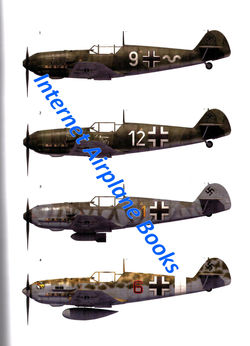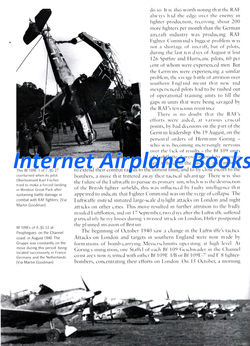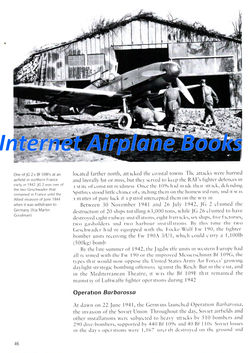MESSERSCHMITT Bf109 E-F
SERIES WW2 GERMAN LUFTWAFFE JG DB601A TRAGER JABO VARIANTS
OSPREY
AIR VANGUARD No.23 SOFTBOUND BOOK by ROBERT JACKSON
THE
PHONEY WAR
THE
NORWEGIAN CAMPAIGN
THE
BATTLE OF FRANCE 1940
BATTLE
OF BRITAIN
ATTACK
OF THE EAGLE ADLER TAG
THE
Bf109F ENTERS COMBAT
THE
CHANNEL FRONT 1941-42
OPERATION
BARBAROSSA INVASION OF THE SOVIET UNION 1941 RUSSIA EASTERN FRONT
NORTH
AFRICA AND THE MEDITERRANEAN 1941-42 DAK DEUTSCHE AFRIKA KORPS (HANS JOACHIM
MARSEILLE – STAR OF AFRICA)
---------------------------------------------------------------------------------------------------------------------
Additional
Information from Internet Encyclopedia
In late 1938, the Bf 109E entered production. To improve
on the performance afforded by the 441–515 kW (600–700 PS) Jumo 210, the
larger, longer Daimler-Benz DB 601A engine was used, yielding an extra 223 kW
(300 PS) at the cost of an additional 181 kg (400 lb). A much bigger cooling
area was needed to disperse the extra heat generated by the DB 601 and this led
to the first major redesign of the basic airframe. Enlarging the existing nose
mounted radiator sufficiently to cool the engine would have created extra
weight and drag, negating some of the performance gains afforded by the
increased power, so it was decided to move the main radiators to beneath the
wings' undersurfaces immediately outboard of the juncture between the wing root
and wing panel, just forward of the trailing edges' inner ends, leaving the oil
cooler under the nose in a small, streamlined duct. The new radiator position
also had the effect of counterbalancing the extra weight and length of the DB
601, which drove a heavier three-bladed Vereinigte Deutsche Metallwerke
(VDM)-made propeller.[14] To incorporate the new radiators, the wings were
almost completely redesigned and reinforced, with several inboard ribs behind
the spar being cut down to make room for the radiator ducting. Because the
radiators were now mounted near the trailing edge of the wing, coinciding with
the increased speed of the airflow accelerating around the wing's camber, the
overall cooling installation was more efficient than that of the Jumo engined
109s, albeit at the cost of extra ducting and piping, which could be vulnerable
to battle damage. In addition, the lowered undercarriage could throw up mud and
debris on wet airfields, potentially clogging the radiators.
To test the new 1,100 PS (1,085 hp, 809 kW) DB 601A
engine, two more prototypes (V14 and V15) were built, each differing in their
armament. While the V14 was armed with two 7.92 mm (.312 in) MG 17s above the
engine and one 20 mm MG FF in each wing, the V15 was just fitted with the two
MG 17s mounted above the engine.[16] After test fights, the V14 was considered
more promising and a pre-production batch of 10 E-0 was ordered. Batches of
both E-1 and E-3 variants were shipped to Spain for evaluation, and first saw
combat during the final phases of the Spanish Civil War.
The E-3 was replaced by the E-4 (with many airframes
being upgraded to E-4 standards starting at the beginning of the Battle of
Britain), which was different in some small details, most notably by using the
modified 20 mm MG-FF/M wing cannon and having improved head armour for the
pilot. With the MG FF/M, it was possible to fire a new and improved type of
explosive shell, called Minengeschoß (or 'mine-shell'), which was made using
drawn steel (the same way brass cartridges are made) instead of being cast as
was the usual practice. This resulted in a shell with a thin but strong wall,
which had a larger cavity in which to pack a much larger explosive charge than
was otherwise possible. The new shell required modifications to the MG FF's
mechanism due to the different recoil characteristics, hence the MG FF/M
designation.
The cockpit canopy was also revised to an
easier-to-produce, "squared-off" design, which also helped improve
the pilot's field of view. This canopy, which was also retrofitted to many E-1s
and E-3s, was largely unchanged until the introduction of a welded,
heavy-framed canopy on the G series in the autumn of 1942. The E-4 would be the
basis for all further Bf 109E developments. Some E-4 and later models received
a further improved 1,175 PS (1,159 hp, 864 kW) DB601N high-altitude engine;
known as the E-4/N; owing to priority being given to equipping Bf 110s with
this engine, one fighter gruppe was converted to this version, starting in July
1940.[21] The E-4 was also available as a fighter-bomber with equipment very
similar to the previous E-1/B. It was known as E-4/B (DB 601Aa engine) and
E-4/BN (DB 601N engine). A total of 561 of all E-4 versions were built,[13]
including 496 E-4s built as such: 250 E-4, 211 E-4/B, 15 E-4/N and 20 E-4/BN
Development of the new Bf 109 F airframe had begun in 1939. After February 1940 an
improved engine, the Daimler-Benz DB 601E, was developed for use with the Bf
109. The engineers at the Messerschmitt facilities took two Bf 109 E-1
airframes and installed this new powerplant. The first two prototypes, V21 (Werknummer (Works number) or W.Nr 5602) and V22 (W.Nr 1800) kept the trapeziform
wing shape from the E-1, but the span was reduced by 61 cm (2 ft) by
"clipping" the tips. Otherwise the wings incorporated the cooling
system modifications described below. V22
also became the testbed for the pre-production DB 601E. The smaller wings had a
detrimental effect on the handling so V23,
Stammkennzeichen (factory Code)
CE+BP, W.Nr 5603, was fitted
with new, semi-elliptical wingtips, becoming the standard wing planform for all
future Bf 109 combat versions. The fourth prototype, V24 VK+AB, W.Nr
5604, flew with the clipped wings but featured a modified,
"elbow"-shaped supercharger air-intake which was eventually adopted
for production, and a deeper oil cooler bath beneath the cowling. On all of
these prototypes the fuselage was cleaned up and the engine cowling modified to
improve aerodynamics.
Compared to the
earlier Bf 109 E, the Bf 109 F was much improved aerodynamically. The engine
cowling was redesigned to be smoother and more rounded. The enlarged propeller
spinner, adapted from that of the new Messerschmitt Me 210, now blended
smoothly into the new engine cowling. Underneath the cowling was a revised,
more streamlined oil cooler radiator and fairing. A new ejector exhaust
arrangement was incorporated, and on later aircraft a metal shield was fitted
over the left hand banks to deflect exhaust fumes away from the supercharger
air-intake. The supercharger air-intake was, from the F-1 -series onwards, a
rounded, "elbow"-shaped design that protruded further out into the
airstream. A new three-blade, light-alloy VDM propeller unit with a reduced
diameter of 3 m (9 ft 8.5 in) was used. Propeller pitch was
changed electrically, and was regulated by a constant-speed unit, though a
manual override was still provided. Thanks to the improved aerodynamics, more
fuel-efficient engines and the introduction of light-alloy versions of the
standard Luftwaffe 300 litre drop tank, the Bf 109 F offered a much increased
maximum range of 1,700 km (1,060 mi) compared to the Bf 109 E's
maximum range figure of only 660 km (410 miles) on internal fuel, and with
the E-7's provision for the 300 litre drop tank, a Bf 109E so equipped
possessed double the range, to 1,325 km (820 mi).
The canopy stayed
essentially the same as that of the E-4 although the handbook for the 'F'
stipulated that the forward, lower triangular panel to starboard was to be
replaced by a metal panel with a port for firing signal flares. Many F-1s and
F-2s kept this section glazed. A two-piece, all-metal armour plate head shield
was added, as on the E-4, to the hinged portion of the canopy, although some
lacked the curved top section. A bullet-resistant windscreen could be fitted as
an option. The fuel tank was self-sealing, and around 1942 Bf 109Fs were
retrofitted with additional armour made from layered light-alloy plate just aft
of the pilot and fuel tank. The fuselage aft of the canopy remained essentially
unchanged in its externals.
The tail section
of the aircraft was redesigned as well. The rudder was slightly reduced in area
and the symmetrical fin section changed to an airfoil shape, producing a
sideways lift force that swung the tail slightly to the left. This helped
increase the effectiveness of the rudder, and reduced the need for application
of right rudder on takeoff to counteract torque effects from the engine and
propeller. The conspicuous bracing struts were removed from the horizontal
tailplanes which were relocated to slightly below and forward of their original
positions. A semi-retractable tailwheel was fitted and the main undercarriage
legs were raked forward by six degrees to improve the ground handling. An
unexpected structural flaw of the wing and tail section was revealed when the
first F-1s were rushed into service; some aircraft crashed or nearly crashed,
with either the wing surface wrinkling or fracturing, or by the tail structure
failing. In one such accident, the commander of JG 2 "Richthofen",
Wilhelm Balthasar lost his life when he was attacked by a Spitfire during a test
flight. While making an evasive manoeuvre, the wings broke away and Balthasar
was killed when his aircraft hit the ground. Slightly thicker wing skins and
reinforced spars dealt with the wing problems. Tests were also carried out to
find out why the tails had failed, and it was found that at certain engine
settings a high-frequency oscillation in the tailplane spar was overlapped by
harmonic vibrations from the engine; the combined effect being enough to cause
structural failure at the rear fuselage/fin attachment point. Initially two
external stiffening plates were screwed onto the outer fuselage on each side,
and later the entire structure was reinforced.
The entire wing
was redesigned, the most obvious change being the new quasi-elliptical
wingtips, and the slight reduction of the aerodynamic area to 16.05 m²
(172.76 ft²). Other features of the redesigned wings included new leading
edge slats, which were slightly shorter but had a slightly increased chord; and
new rounded, removable wingtips which changed the planview of the wings and
increased the span slightly over that of the E-series. Frise-type ailerons
replaced the plain ailerons of the previous models. The 2R1 profile
was used with a thickness-to-chord ratio of 14.2% at the root reducing to 11.35%
at the last rib. As before, dihedral was 6.53°.
The wing radiators
were shallower and set farther back on the wing. A new cooling system was
introduced which was automatically regulated by a thermostat with
interconnected variable position inlet and outlet flaps that would balance the
lowest drag possible with the most efficient cooling. A new radiator, shallower
but wider than that fitted to the E was developed. A boundary layer duct
allowed continual airflow to pass through the airfoil above the radiator
ducting and exit from the trailing edge of the upper split flap. The lower
split flap was mechanically linked to the central "main" flap, while
the upper split flap and forward bath lip position were regulated via a
thermostatic valve which automatically positioned the flaps for maximum cooling
effectiveness. In 1941 "cutoff" valves were introduced which allowed
the pilot to shut down either wing radiator in the event of one being damaged;
this allowed the remaining coolant to be preserved and the damaged aircraft
returned to base. However, these valves were delivered to frontline units as
kits, the number of which, for unknown reasons, was limited.
The armament of
the Bf 109 F was revised and now consisted of the two synchronized 7.92 mm
(.312 in) MG 17s with 500 rpg above the engine plus a Motorkanone cannon firing through the
propeller hub. The pilot's opinion on the new armament was mixed: Oberst Adolf Galland criticised the
light armament as inadequate for the average pilot, while Major Walter Oesau preferred to fly a
Bf 109 E, and Oberst Werner
Mölders saw the single centreline Motorkanone
gun as an improvement.
With the early
tail unit problems out of the way, pilots generally agreed that the F series
was the best-handling of all the Bf 109 series. Mölders flew one of the first
operational Bf 109 F-1s over England from early October 1940; he may well have
been credited with shooting down eight Hurricanes and four Spitfires while
flying W.No 5628, Stammkennzeichen SG+GW between 11 and 29 October 1940.















